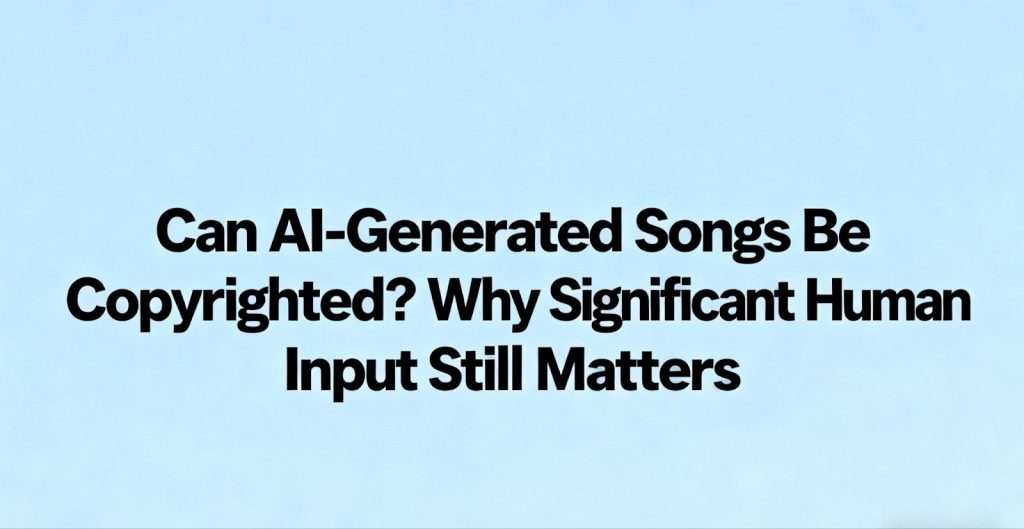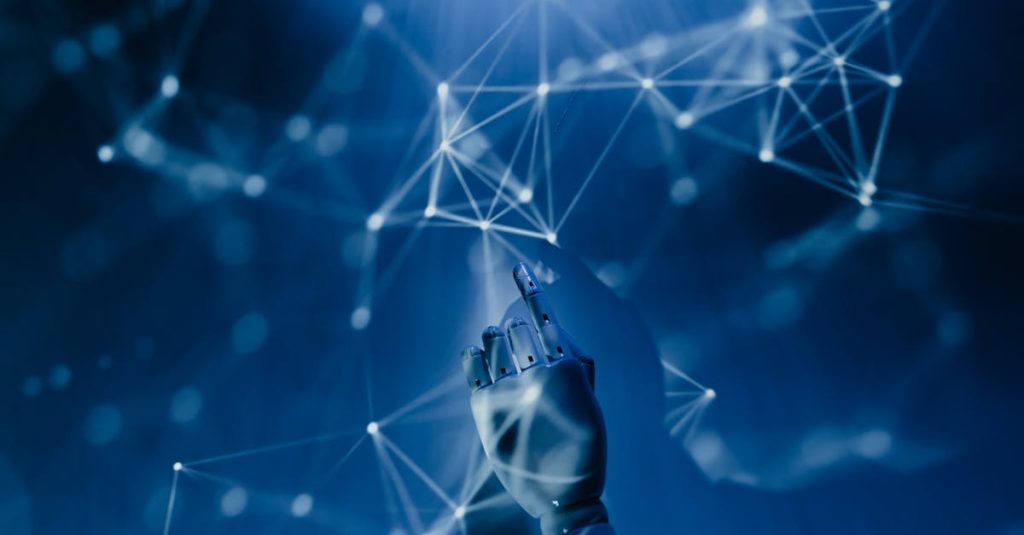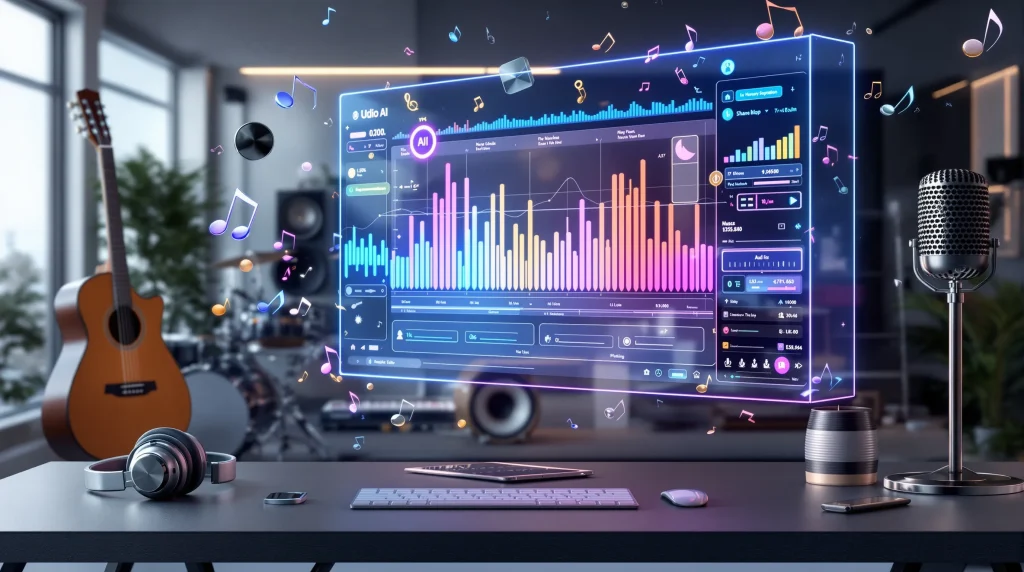인공지능은 이제 인간의 창작물에 필적하는 멜로디를 작곡하지만 저작권법은 인간의 저작물과 독창성에 달려 있습니다. 인공지능이 만든 노래가 보호 대상이 되는지 여부를 이해하려면 지적 재산권 규칙, “상당한 인적 투입” 원칙, 미국 저작권청의 지침, 창작자가 사용하는 실질적인 방법 등을 명확히 파악해야 합니다. Mureka와 같은 도구 자신의 권리를 보호할 수 있습니다. 이 문서에서는 기본적인 저작권 개념을 설명하고, 인간의 창작물 관리의 한계를 정의하고, 공식 가이드라인과 법적 판례를 검토하고, Mureka의 편집기 는 저작권이 있는 저작물을 강화하고, 소유권 결과를 명확히 하며, 일반적인 사용자 우려 사항을 해결하고, 새로운 라이선스 모델과 윤리적 고려 사항에 대한 미래 지향적인 관점을 제공합니다. 뮤지션과 애호가들은 제너레이티브 AI와 실습 편집을 결합하여 자신의 작곡이 독창성 기준을 충족하고 미국 법률에 따라 보호받을 수 있도록 하는 방법을 배울 수 있습니다.
저작권이란 무엇이며 AI 생성 음악에 저작권이 어떻게 적용되나요?
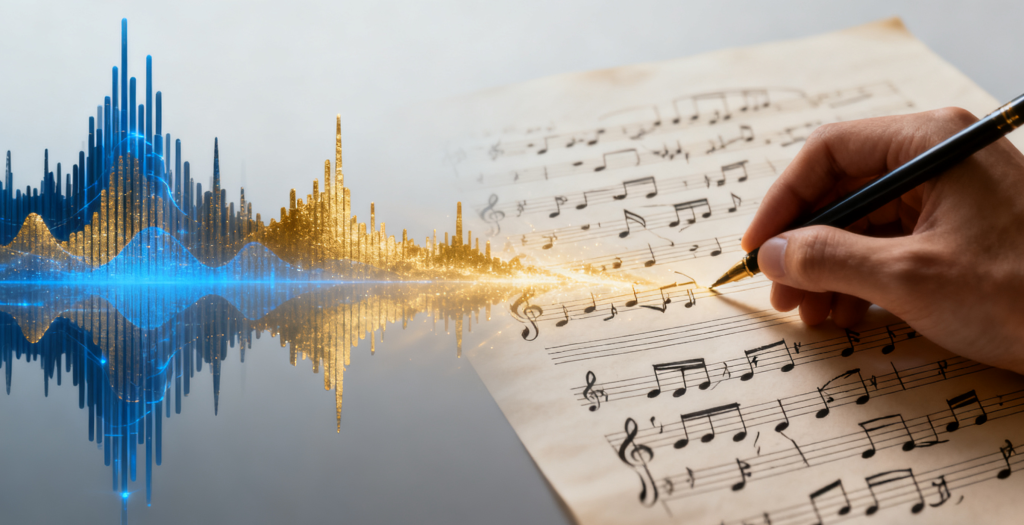
저작권은 창작자에게 음악 작곡을 포함한 원본 저작물을 복제, 배포, 각색할 수 있는 배타적 권리를 부여합니다. 저작권은 멜로디, 화음, 리듬과 같은 표현적 요소를 보호하여 저작자의 창의적인 선택을 인정합니다. AI가 악기 트랙을 생성할 때 인간 저작자가 없으면 결과물이 보호되지 않을 수 있지만, 사용자 주도의 편집을 통합하면 법적 기준을 충족하는 저작자 표시를 도입할 수 있습니다.
AI 지원 곡에 저작권을 적용하려면 크리에이터는 반드시 저작권을 적용해야 합니다:
- 사람이 직접 선택한 프롬프트, 스타일 또는 샘플을 시연합니다.
- 편곡, 악기 변경, 가사 입력 등의 수정을 적용합니다.
- 순수하게 기계적인 결과물과 구별되는 창의적인 결정을 문서화하세요.
아래는 저작권법상 표준 음악 저작물과 인공지능 저작물을 비교한 것입니다:
| 작업 유형 | 저작권 요구 사항 | AI 음악에 적용 |
|---|---|---|
| 사람이 작곡한 노래 | 오리지널 멜로디와 가사 | 유형 매체에 고정된 경우 기본적으로 보호됨 |
| 순수 AI 출력 | 인간 저작물 없음 | 사용자가 크리에이티브 편집을 추가하지 않으면 사용할 수 없습니다. |
| AI + 인간 협업 | 입증 가능한 크리에이티브 제어 | 사용자 입력이 구조 또는 표현식을 형성하는 경우 적용 가능 |
이러한 구분을 매핑함으로써 크리에이터는 AI가 삽입된 트랙이 독창성 요건을 충족하고 작곡에 대한 법적 보호를 확보할 수 있습니다.
음악 저작물에 대한 저작권 보호는 어떻게 정의되나요?
음악의 저작권 보호를 위해서는 유형 매체에 고정된 독창적인 표현이 필요합니다. 법원은 멜로디, 화음, 서정적인 편곡에 대해 일상적이거나 기능적인 선택을 넘어선 창의성을 평가합니다. 오리지널 곡에는 작곡가의 독특한 음표 배열, 코드 진행, 다이나믹 구조가 반영되어 있어 독점적 권리의 근거가 됩니다.
저작권법은 인공지능이 생성한 콘텐츠를 어떻게 다루나요?
미국 법은 인간의 저작물을 의무화하고 있으며, 순수 알고리즘의 결과물에는 창작성이 결여되어 있습니다. AI 도구가 음악을 생성할 때 결과물에 장르 템플릿 선택, 모티브 편집, 섹션 재배치 등 사용자 주도의 결정이 포함되어야 연방법에 따라 오리지널 저작물로 인정받을 수 있습니다.
미국 저작권청은 AI가 만든 저작물 자체는 사람의 개입 없이 자동으로 저작권 보호를 받을 수 없다는 입장을 명확히 했습니다.
AI 생성 음악 및 저작물에 대한 미국 저작권청의 입장
미국 저작권청은 현재 AI가 창작한 저작물은 저작권에 해당하지 않는다고 명시하고 있습니다. 인공지능 소프트웨어가 헌법에 규정된 인공지능 이전의 저작자 개념과 어떻게 관련되는지에 대한 최신 이해 없이는 인공지능이 생성한 음악과 관련된 어떤 주체(개발자, 사용자, 시스템 자체 등)에게도 기존 인간 아티스트의 저작권 침해에 대한 책임을 물을 수 없습니다. 따라서 본 논문에서는 인공지능이 생성한 음악에서 발생하는 저작권 침해와 인간이 만든 음악에서 발생하는 저작권 침해 사이에 중대한 차이가 있는지를 명확히 하고자 합니다.
AI 음악 저작권에서 오리지널리티는 어떤 역할을 하나요?
독창성은 최소한의 창의성과 독립적인 창작을 요구합니다. AI 지원 음악의 경우, 인간이 특정 하모니를 선택하거나 리듬 패턴을 사용자 지정하거나 독특한 악기를 오버레이하는 등 AI 결과물을 구체화할 때 독창성이 드러나므로 최종 작품에는 사용자의 독창적인 표현이 드러나게 됩니다.
AI 음악 저작권에서 “중요한 사람의 입력”이란 무엇을 의미하나요?
“상당한 인적 입력”이란 사용자가 AI가 생성한 자료에 대해 실질적인 창작 통제권을 행사하는 것을 의미합니다. 여기에는 단순히 버튼을 클릭하는 것뿐만 아니라 멜로디를 다듬고, 섹션을 조화시키고, 개인의 예술성과 독창성을 반영하는 서정적인 테마를 적용하는 등의 창의적인 결정이 포함됩니다.
중요한 입력의 주요 측면은 다음과 같습니다:
- 프롬프트 공식화 또는 스타일 선택과 같은 아이디어 선택 사항.
- 섹션 잘라내기, 재배열 또는 확장과 같은 구조적 편집.
- 멜로디 조정, 다이나믹 조정 또는 서정적인 구성을 통해 개인화할 수 있습니다.
이러한 단계를 문서화함으로써 크리에이터는 인간의 독창성이 어떻게 AI 초안을 보호받는 음악 작품으로 변환하여 기계 생성과 예술적 저작물을 연결하는지 보여줍니다.
저작권법에서 인간의 저작물은 어떻게 정의되나요?
인간 저작물에는 기계가 아닌 사람이 창의적인 요소를 구상하고 실현하는 것이 포함됩니다. 법적 해석은 리듬의 변화, 멜로디의 변화, 주제적 내용 등 개인의 결정이 자동화된 결과물이 아닌 개인의 창의성을 반영하는지에 초점을 맞추고 있습니다.
인간의 창의적 통제에는 어떤 유형이 중요한 입력으로 인정되나요?
창의적인 제어는 AI가 제안하는 코드를 일관된 진행으로 배열하거나, 추가 악기를 레이어링하거나, AI가 생성한 비트에 맞춰 독창적인 가사를 작성하는 등의 형태로 이루어집니다. 각 개입은 사소하지 않아야 하며 사용자의 표현적 선택을 구현해야 합니다.
AI 노래의 저작권 적격성에 사람의 입력이 필수적인 이유는 무엇인가요?
사람이 입력하면 저작자가 고정되어 법적 보호를 받을 수 있습니다. 입증 가능한 편집이 없으면 AI 창작물은 저작자가 소유권을 주장할 수 없어 독점권을 가질 수 없습니다. 중요한 사용자 기여는 기계로 만든 초안을 저작권법이 보호하는 독창적인 저작물로 전환합니다.
미국 저작권청은 AI로 생성된 음악 저작권에 대해 어떻게 안내하나요?
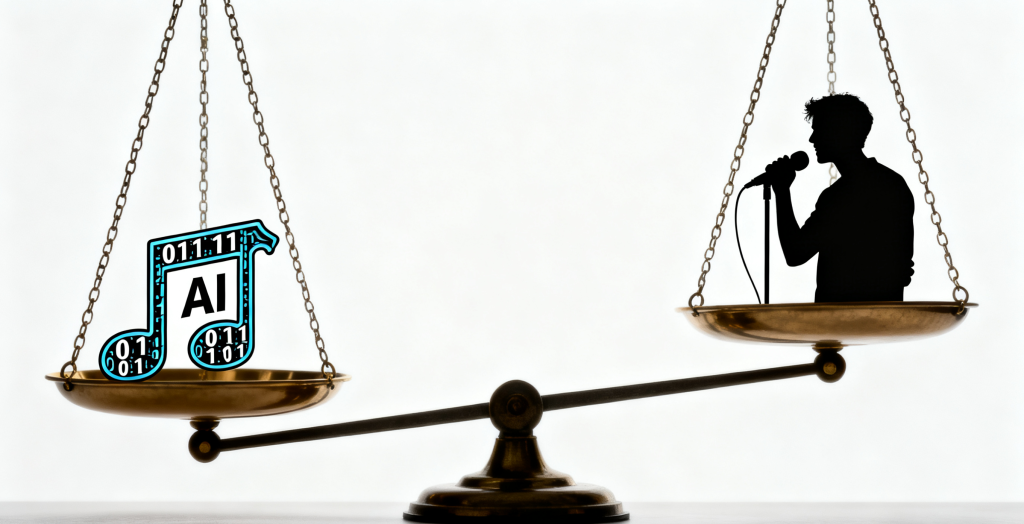
미국 저작권청은 창작물에는 반드시 사람의 저작물이 있어야 한다고 규정하고 있으며, 최근 정책 업데이트를 통해 이러한 입장을 재확인했습니다. 이 기관의 회람은 AI 전용 결과물은 보호 대상이 아니지만, 사람이 편집한 AI 저작물은 사용자의 기여가 독창성 기준을 충족하는 경우 보호 대상이 될 수 있다고 명시하고 있습니다.
주요 지침 주요 내용
- 순수하게 AI가 생성한 자료는 등록할 수 없습니다.
- 신청자가 창작물 편집의 성격과 범위를 자세히 설명하면 등록에 성공합니다.
- 지원자는 사람의 개입이 작품에 어떤 영향을 미쳤는지 설명해야 합니다.
다음은 최근 가이드라인과 평가 기준에 대한 개요입니다:
| 가이드라인 측면 | 설명 | AI 음악에 미치는 영향 |
|---|---|---|
| 등록 자격 | 사람이 직접 작성한 크리에이티브 요소 필요 | 사용자는 등록 양식에 편집 결정을 설명해야 합니다. |
| 제출 서류 | 창작 과정 및 입력에 대한 내러티브 | 신속한 선택, 편곡 편집, 가사 입력 시연 |
| 법적 판례 참조 | 최근 순수 인공지능 만화책 등록이 거부된 사례 | 실질적인 인간 개입의 필요성 강화 |
이 공식 프레임워크는 AI 지원 작곡이 알고리즘에서 저작권이 있는 저작물로 전환되는 과정을 고정하고, 창작자에게 등록 절차를 안내합니다.
미국 저작권청과 협력 목록화 프로그램(PCC)의 최근 정책 업데이트는 저작권 자격에 대한 인간 저작의 필요성을 강조하는 동시에 현재 프레임워크의 잠재적 모순을 지적합니다.
AI 음악 저작권: 미국 저작권청 정책 및 카탈로그 가이드라인
이러한 추세에 대응하기 위해 미국 저작권청은 저작권 등록 대상에 대한 명확한 정의를 내리는 최신 정책 개정안을 발표했습니다. 얼마 지나지 않아 협력 목록 작성 프로그램(PCC)도 새로운 가이드라인을 발표하여 도서관 목록 작성자가 AI로 생성된 자료를 어떻게 다뤄야 하는지에 대한 권장 사항을 제시했습니다. 두 경우 모두 AI를 기여자로 간주하는 개념을 거부합니다. 그러나 이러한 각 정책의 언어는 자기 모순적이며, 생성형 AI를 다룰 준비가 되어 있지 않다는 것을 보여줍니다.
AI 음악에 대한 미국 저작권청의 최신 가이드라인은 무엇인가요?
최근의 회람은 사람이 편집한 AI 초안과 같이 인간의 창의성이 반영된 저작물만이 보호 대상임을 명확히 하고 있습니다. 저작권 사무소는 멜로디, 구조 또는 가사의 사용자 주도적 선택에 대한 투명한 문서화를 강조합니다.
미국 저작권청은 AI 저작물에서 사람의 의견을 어떻게 평가하나요?
심사관은 독창성을 확인하기 위해 편집 조치, 도구 추가, 역학 커스터마이징 등 창의적인 단계를 설명하는 내용을 평가합니다. 지원자는 각 개입이 어떻게 AI 결과물을 독창적인 작품으로 변화시켰는지 명확하게 설명해야 합니다.
AI 음악 저작권 결정에 영향을 미치는 법적 판례는 무엇인가요?
인공지능 저작물에 대한 저작권을 부정하는 판례는 창의성은 인간에게서 비롯된다는 원칙을 강조합니다. 편집되지 않은 AI 결과물을 기반으로 한 만화 등록 거부와 같은 판결은 음악 작곡에 대한 현재의 법적 환경을 형성합니다.
Mureka의 AI 음악 생성기는 저작권이 있는 창작물을 어떻게 지원하나요?
Mureka 는 직관적인 편집기를 제공하여 사용자가 AI가 생성한 트랙에 독창적인 창의력을 불어넣을 수 있도록 지원합니다. 제너레이티브 컴포지션과 직접 다듬는 작업을 결합한 것이죠, Mureka 는 기계의 제안과 인간의 예술성을 연결하여 각 트랙이 실질적인 사용자 의견을 구현하도록 합니다.
Mureka를 사용하는 크리에이터는 다음과 같은 혜택을 누릴 수 있습니다:
- AI를 구체적으로 안내하는 유연한 프롬프트 인터페이스 스타일.
- 멜로디 변형, 코드 진행 조정, 다이나믹 레이어링을 위한 실시간 편집 도구.
- 등록 지원을 위한 모든 사람의 개입을 문서화하는 버전 기록.
이러한 워크플로우를 통해 Mureka 사용자는 “중요한 인적 입력” 기준을 충족하고 자신의 예술적 기여를 입증하여 자신 있게 등록을 신청할 수 있습니다.
Mureka의 에디터는 어떻게 사람의 의견을 중요하게 받아들일 수 있을까요?
에디터를 사용하면 AI가 제안하는 루프를 수정하고, 템포와 키를 변경하고, 독특한 전환을 만들 수 있으며, 각 편집 내용은 프로젝트 타임라인에 기록되어 저작권 신고를 위해 사람의 저작물임을 입증할 수 있습니다.
독창성을 높이기 위해 무레카는 어떤 크리에이티브 툴을 제공하나요?
Mureka 는 사용자 지정 가능한 도구 팔레트를 제공합니다, 가사 프롬프트 필드, 그리고 크리에이터가 개인화된 창의적 결정을 통해 AI가 생성한 자료를 재구성할 수 있는 편곡 모듈이 있습니다.
Mureka 사용자는 AI가 생성한 노래를 어떻게 보호할 수 있나요?
프로젝트 로그와 편집 요약을 내보내면 저작권 사무소에서 요구하는 프롬프트 공식, 편곡 선택, 가사 기여도, 최종 믹싱 결정 등을 명확하게 설명하는 등록 서류를 작성할 수 있습니다.
Mureka로 생성된 AI 생성 곡의 저작권은 누가 소유하나요?
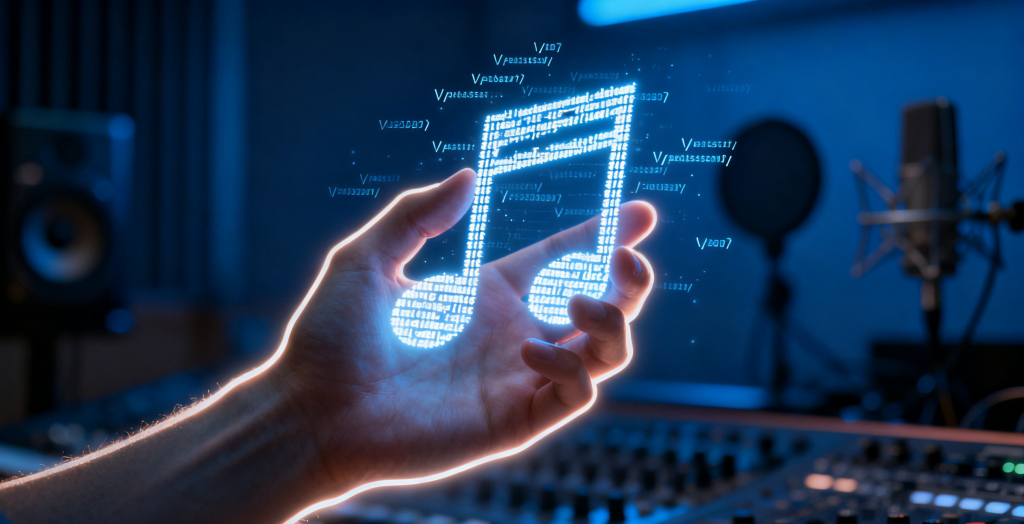
사용자가 다음을 통해 중요한 크리에이티브 제어권을 행사하는 경우 무레카의 도구, 의 저작권은 일반적으로 해당 저작자에게 있습니다. 소유권은 최종 작품을 독창적인 저작물로 정의하는 디자인, 멜로디 편집, 편곡 수정 등 문서화된 기여도에 따라 결정됩니다.
주요 소유권 원칙은 다음과 같습니다:
- AI 프로세스를 지시하고 개선하는 사용자가 저작권을 보유합니다.
- 공동 프로젝트에서 여러 사람이 서로 다른 창작물을 제공하는 경우 공동 저작자를 지정할 수 있습니다.
- 라이선스 옵션은 사용자 선호도에 따라 독점적 권한 제어부터 비상업적 공유까지 다양합니다.
Mureka의 명확한 편집 기록은 소유권 경계를 설정하고 수익화 결정을 지원합니다.
AI 지원 음악의 저작권 소유권은 어떻게 결정되나요?
소유권은 리듬, 멜로디, 하모니 등 작품의 필수 요소에 대한 창의적인 결정을 내리고 그러한 개입에 대한 증거를 제시할 수 있는 당사자에게 있습니다.
AI 음악의 라이선스 및 수익 창출 옵션은 무엇인가요?
크리에이터는 독점 또는 비독점 라이선스를 부여하거나 로열티 공유 계약을 체결하거나 저작자 권리를 보유하면서 저작물을 크리에이티브 커먼즈 라이선스에 따라 배포할 수 있습니다.
사람의 입력과 편집이 저작권 소유권에 어떤 영향을 미치나요?
원본 가사 추가, 코드 시퀀스 재작업, 다이나믹 개인화 등 편집의 범위와 성격에 따라 사용자는 결과 트랙의 저작자이자 저작권 소유자로서 지위를 공고히 할 수 있습니다.
AI 음악 저작권과 사람의 입력에 대한 일반적인 질문은 무엇인가요?
사용자는 종종 AI 트랙이 보호를 받을 수 있는지, 창작자 통제권을 증명하는 방법, 사람이 편집하지 않은 공개 도메인 상태의 위험성에 대해 궁금해합니다. 이러한 우려를 해결하면 크리에이터가 안심하고 등록 및 저작권 관리를 진행할 수 있습니다.
AI가 생성한 음악도 미국에서 저작권이 있나요?
예, 작곡가가 프롬프트 선택, 멜로디 편집, 가사 작성 등 상당한 창작 통제권을 행사하는 경우 AI 지원 트랙은 독창성 요건을 충족하며 미국 저작권 보호를 받을 수 있습니다.
AI 음악의 “중요한 인간 입력'을 구성하는 요소는 무엇인가요?
중요한 입력 사항에는 섹션 순서 변경, 악기 사용자 지정, 멜로디 미세 조정, 원본 가사 오버레이 등 개인의 예술성을 반영하는 사소한 편집도 포함됩니다.
AI가 생성한 노래는 사람의 입력 없이 퍼블릭 도메인으로 간주되나요?
예, 편집되지 않은 AI 결과물에는 저작자가 없으며 보호되지 않으므로 이러한 저작물은 제한 없이 사용할 수 있는 퍼블릭 도메인에 속합니다.
크리에이터는 어떻게 자신의 인간적인 기여를 보여줄 수 있을까요?
상세한 편집 로그를 유지하고, 프로젝트 내역을 내보내고, 즉각적인 발전 과정을 문서화하면 창작 과정을 설명하고 등록 요건을 충족할 수 있습니다.
인공지능 음악 저작권의 향후 동향과 법적 발전은 어떻게 될까요?
AI 도구가 확산됨에 따라 법적 프레임워크와 라이선스 모델도 혁신과 아티스트 권리 사이의 균형을 맞추기 위해 진화할 것입니다. 새로운 접근 방식에는 AI로 생성된 스템에 대한 구독 기반 라이선싱, 공동 저작물을 위한 마켓플레이스 플랫폼, 사람의 의견을 포착하는 표준화된 메타데이터 스키마 등이 있습니다.
업계 관계자들은 이렇게 예상합니다:
- AI 협업에 대한 국제 저작권 사무소의 지침이 확대되었습니다.
- 인간과 기계의 기여를 모두 인정하는 새로운 로열티 공유 프레임워크.
- 투명성과 공정한 어트리뷰션을 촉진하는 윤리적 AI 가이드라인.
최신 정보를 유지하고 Mureka와 같은 도구 를 통해 음악가들은 창의적인 선택을 기록함으로써, 제너레이티브 AI가 음악 창작을 재편하는 역동적인 환경에 적응하고 자신의 노력을 보호받을 수 있습니다.
인간의 강력한 창의력과 투명한 편집 워크플로우가 결합되어 아티스트가 소유권과 통제권을 유지하면서 기술을 활용할 수 있는 차세대 저작권 AI 음악 시대를 정의할 것입니다.
다른 관할권에서도 AI 지원 저작물에 대한 법적 환경을 검토하고 있으며, 기존 저작권 프레임워크가 새로운 창작 과정에 적응할 수 있는지에 초점을 맞춘 분석이 이루어지고 있습니다.

